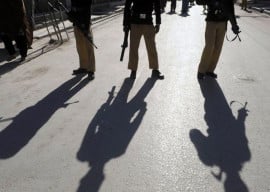
It took two hours of rain to wreck Karachi on Saturday and the worst isn’t over. The city can expect more thundershowers today as well.
The battering began around 2pm and was laced with claps of thunder that are otherwise rarely experienced in Karachi. By the end of the afternoon, Saddar recorded the most downpour of 40mm and at least nine people were electrocuted to death, including five of one family. From Clifton to Gulistan-e-Jauhar thousands of people got stuck on the roads and there were reports that people were robbed at gunpoint in the traffic jams.
Why is this happening
For many the simple question is why the civic authorities can’t learn from the same disasters each year. According to the experts, better coordination while planning roads with drainage and sewage systems can prevent the inundation.
What does Karachi expect if its drains are blocked, says urban planner and historian Arif Hasan, who is also the author of ‘Understanding Karachi: Planning and Reform for the Future’. “The construction of Mai Kolachi has blocked two main drains,” he told The Express Tribune. “Water is now forced to go through a small 60-foot nullah [into the sea].”
This blockage has increased the time it takes for the water to flow out into the sea by at least four to five times, if not 10. “Of course, the time it takes [for the water to flow out] is dependent on the amount of rain and the sea tide,” he explained. If it is high tide at sea then the water trying to flow into the sea might be forced back, making the process even slower.
This situation is exacerbated by squatters. There are 13 nullahs or natural drains in the city and most of the drainage systems are connected to them, says professor of architecture and planning at the Nadirshaw Edulji Dinshaw (NED) University of Engineering and Technology, Noman Ahmed, who has written a book on the water supply in Karachi. “But with heavy encroachments, both by developments of katchi abadis as well as some unscrupulous local developers, the water flow has been blocked.”
For Arif Hasan though, the encroachments of unplanned settlements pale in comparison with the “land hunger of the elite.” Most of these outfall drains are located on valuable land in Clifton and Defence. The city’s southern parts are significantly more densely populated than its northern areas. The southern side is also where most drains and sewage systems are located - therein lies the problem.
“They have encroached by constructing buildings, houses in Kehkashan in Clifton, shops, parking spaces even an MPA hostel,” Hasan says. “Naturally, if you encroach, and drainage systems are blocked, there will be problems.”
Another example is the construction of signal-free corridors undertaken by expanding major neighbourhoods by taking in service roads. This construction, on many occasions, builds over an already existing drainage system or in other instances ends up taking space previously allocated to one. “Such constructions are so haphazard that they have blocked most of the storm drains, compounding the issue,” Noman Ahmed adds.
“You can build any and all the drainage systems you want but if there is any impendent to it [water and sewage] entering the sea there will be problems,” Hasan further explains.
As Karachi struggles under the weight of an 18-million person strong population, one of the biggest casualties is garbage disposal. “The system for the disposal of solid waste has almost collapsed over the last four, five years. What happens is that people in charge of disposing the waste are dumping it in the nullahs which is clogging them.”
Uneven land is another issue. Lyari, for example, is located at a depression, and rain water needs to be pumped out from the area as there is no natural route for it to spill out. “Some areas are located lower than sea level, thus a natural spill does not occur and in this case you get a backflow and the sewage and drainage system fail to function,” Ahmed says.
Published in The Express Tribune, September 11th, 2011.
COMMENTS (1)
Comments are moderated and generally will be posted if they are on-topic and not abusive.
For more information, please see our Comments FAQ

















Fortunately it does not rain often in Karachi. A heavy downpour is a rare event once in a couple of years. Otherwise the havoc water will wreak on the city would be unimaginable. This situation is symptomatic of the general breakdown of the infra-structure and the haphazard development that has taken place in the recent past with no regard to long term planning. This situation is not an isolated event; rather it is a phenomenon inter-connected with different facets of socio-political-economic life of the city and the country. Urbanization because of lack of sustainable development of the interior of the country is taking place at an accelerated pace. The breakdown of law and order, alongside with power and water shortages, is hampering normal operations of commerce and industry. Add to it the administrative appointments of totally untrained and unqualified civil administrave managers on the basis of political affiliations and you have a disaster on hand. The civil servants of yesteryears were a product of the ICS (Indian Civil Service) trained in the British system of administration and were largely untouched by corruption and financial malfeasance. The only solution to this horrific scenario is a return to sanity; astute urban planning, staffing on merit basis, decent and livable wages for the civil and police personnel, and a strong commitment to civic responsibility. Take your pick; either manage properly or live in a hell-hole.